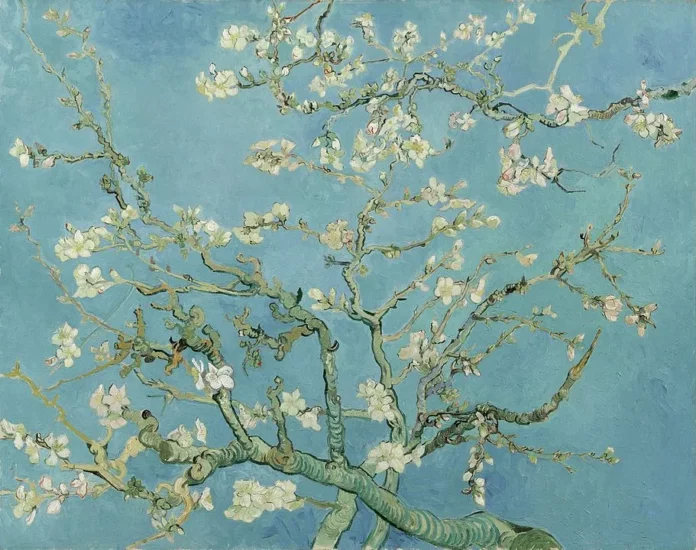10 Secrets of “Almond Blossom”
1) The 1890 painting “Almond Blossom” was Van Gogh’s gift to his newly born nephew and namesake.
2) Van Gogh arrived in Arles in the spring of 1888 on the heels of a late snowfall. Housebound, he spent his first week painting such still life treatments as “Blossoming Almond in a Glass” and “Blossoming Almond Branch in a Glass with a Book.”
3) He produced just about a painting of a flowering tree each day during the first month of his visit, including some of almond blossoms.
4) The “Almond Blossom” series of paintings contains strong elements of the Japanese Ukiyo-e prints that Van Gogh had been collecting. These elements include:Cropping of the image, Bold outlines of the branches, Absence of perspective/horizon, and Large, bright blocks of color.
5) Van Gogh’s “Almond Blossom” was part of a recent “Van Gogh and Japan” joint exhibition of his own works and Japanese paintings.
6) After Vincent’s and Theo’s death, “Almond Blossoms” went to Theo’s widow, Joanna Van Gogh Bonger, and then to V.J. Van Gogh. The Van Gogh Foundation acquired the canvas in 1960, and it now resides at the Van Gogh Museum in Amsterdam.
7) In his May 3, 1890 letter to Vincent, Theo praises the “Almond Blossoms,” which his brother had sent in a group of works to Paris, as “very, very beautiful.”
8) Ironically the artist completed his final painting of the blossoming tree, an image of rebirth and new life, a few short months before his death by suicide.
9) Theo and Joanna hung the final version of “Almond Blossoms” above their infant son’s bed. Joanna wrote to the elder Vincent that it “seems to enthrall him.”
10) Due to a fresh onset of illness during his work on “Almond Blossoms” in February 1890, the artist was unable to go out and paint the other flowering trees that spring, telling his brother Theo in a letter, “Really, I have no luck.”

What makes this painting famous?

To put it simply, Van Gogh’s Almond Blossoms are beautiful. The subject matter is aesthetically pleasing, and the artist’s joy in painting them can be clearly seen in the outcome. This particular painting is the most famous out of an entire series devoted to blossoming almond trees.
One little-known fact about Van Gogh is that he was obsessed with Japanese art, and greatly influenced by ukiyo-e woodcuts and prints.
The inspiration behind the work can be clearly traced back to this Japanese art style, with the 1887 work Japonaiserie Flowering Plum Tree (after Hiroshige) – also pictured here – being both an homage to the Japanese artist Hiroshige, and a foreshadowing of Van Gogh’s own masterpiece.
What’s the background story?
Van Gogh enjoyed the most productive era of his career during his time in Southern France, referring to Arles as “the Japan of the South” due to its abundance of sunlight and flowering trees. He first arrived in March 1888, as the fruit trees began to blossom, and immediately began painting at an almost unprecedented rate:
“I am up to my ears in work for the trees are in blossom and I want to paint a Provençal orchard of astonishing gaiety.”
This particular work, Van Gogh’s most famous painting of almond blossoms, was created for another special reason: the birth of his nephew, the son of his brother Theo. It’s one of the rare Van Gogh paintings in which you can see hope, joy, and serenity – which makes it all the more special.
Where is it?
Van Gogh Museum, Amsterdam.
Sources: https://www.tiqets.com; https://www.vincentvangogh.org




